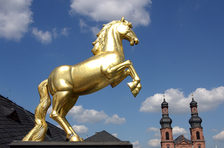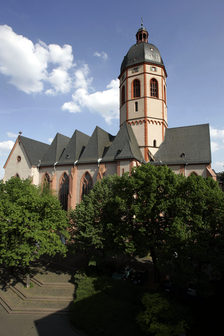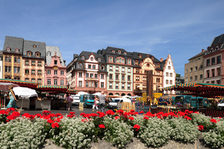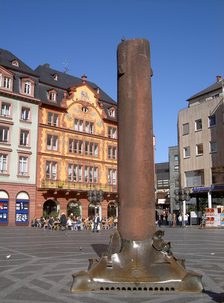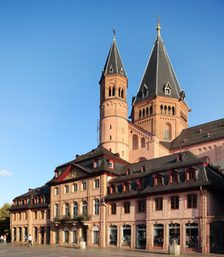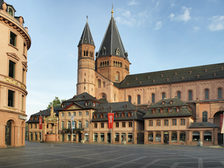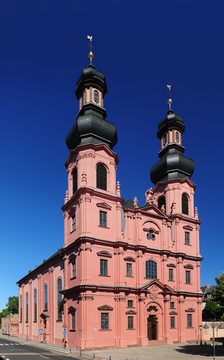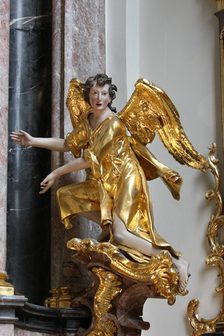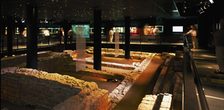City walk: Museums, churches and palaces
Are you just passing through Mainz or only staying for a little while and want to explore the capital of Rhineland Palatinate on your own and on foot? This virtual city walk will assist you with your historical journey through time.
Discover the city's ancient roots with the theme walk "museums, churches and palaces". On the tour, you will also get to know the Electorate of Mainz and the city’s most famous son, Johannes Gutenberg.
Further information
can be found on the "Historical Mainz" slabs in front of the attractions and on mainz.de
Route information
Suitable for
everyone who wants to experience a large portion of Mainz within a few hours.
Accessibility
is not ensured.
Duration
approx. 2 and a half to three hours
Route
Citywalk
1. Carnival Fountain – Osteiner Hof – Bassenheimer Hof
Carnival Fountain
Your tour begins at Schillerplatz in front of the Fastnachtsbrunnen (carnival fountain) - which is vitally important to all real "Meenzer" (people from Mainz): Every year on 11/11, all people celebrating Carnival in Mainz gather here when the clock on the balcony of the facing Osteiner Hof (Court of Ostein) strikes 11 minutes past 11, which marks the "fifth season" of Carnival. Carnival is traditionally opened with the announcement of the 11 carnival laws.
The 8.50 metre-high carnival fountain, unveiled in 1967, designed by Blasius Spreng, is a comparatively young monument in Mainz. Nevertheless, you can't imagine it not being in the cityscape. With over 200 figures from carnival and mythology, it is a symbol of typical Mainz joie de vivre.
Look a little closer - which figures do you recognise? Father Rhine, the monk and the man with the blockhead, the cat, Till Eulenspiegel and the city goddess, Mogontia, the purse scrubber and the paragraph rider. They are all examples of the variety of fantasy motifs that populate the Carnival fountain.
Osteiner Hof
You will encounter the route's first palace directly opposite. The Osteiner Hof (Court of Ostein) was built in the mid-18th century as a family palace for the prince-elector, Johann Friedrich Karl von Ostein. When Napoleon's occupying forces and military authorities moved in, it was also commonly known as the "Gouvernement". From 1958 until 2014, the palace functioned as headquarters for the German armed forces.
Bassenheimer Hof
Bassenheimer Hof (Bassenheimer Palace) extends from here to Schillerstraße. This palace was also built around 1750 for the prince-elector's widowed sister. Today, Bassenheimer Palace is the seat of the Ministry of the Interior.
Let's continue up Gaustraße - which of late has also been humorously known as the "San Francisco of Mainz". Nevertheless, the Gaustraße tramway, opened in 1923, is the steepest in Germany, with an incline of up to nine percent. Cafés, restaurants, wine and cocktail bars and proprietor-run shops to the left and right of the tramway invite you to have a break or take a stroll.
Interactive route
2. St. Stephan's - Chagall Windows
St. Stephan
Before the junction on the left-hand side, you will reach the Gothic hall church, St. Stephan's, constructed between 1260 and 1340. Since it is the biggest church building in the city after the cathedral, it is also known as the "second Mainz cathedral". The famous windows by Marc Chagall make St. Stephan's a tourist attraction which attracts visitors from all over the world every year.
Chagall-windows
Colourful images from the Old Testament stand out from the dominating bright blue background. You will have to admit: a visual experience worth seeing. Incidentally, Marc Chagall was 98 years old when he created the last of these nine windows shortly before his death. St. Stephan's was almost completely destroyed by bombing raids in the Second World War. The octagonal tower in the cloister threatened to topple down due to a crack reaching from top to bottom. It ultimately owes its salvation to the rebellious character of Mainz spirit, which persistently and successfully opposed the planned demolition.
Before you leave the church, don't miss out on a visit to the beautiful late-Gothic cloister. It is as if you're stepping into another world which doesn't exist in time. The peace and quiet that prevails here is almost palpable and has a relaxation spa-like effect.
Follow Willigisstraße down into Mainz old town.
Interactive route
3. Kirschgarten – Augustinerstraße – St. Augustine's Church
Kirschgarten
The first stop in Mainz old town is the Kirschgarten (cherry garden) with its romantic timbered houses and Marienbrunnen fountain. Incidentally, both the square and the street share the name "Kirschgarten". This is often mistakenly attributed to the tree stump which can be found by the bakery "Zum Beymberg" (house no. 19). This is actually an oak stump.
However, in her dissertation "Names of Streets and Places in Mainz" (published in 2008 by Franz Steiner Verlag (publishers) Stuttgart), Dr Rita Häuser traces the name back to a large garden area with cherry trees that was located here in the Middle Ages. The "Kirschborn" (Cherry Spring) spring also has its source nearby.
Augustinerstraße
The Kirschgarten leads you directly to the picturesque Augustinerstraße - Mainz old town's promenade. It was the city's main shopping street until the 17th century. Today it offers wide range of everything that the people of Mainz, and particularly visitors to Mainz, desire. You will find small shops and boutiques, cafés, wine bars and wine shops, pubs and restaurants with a typical Mainz atmosphere from one end to the other, as well as in the small branched off streets.
Augustinerkirche
In the midst of the hustle and bustle is the magnificent Augustinerkirche (St. Augustine's Church) with its Baroque façade incorporated into the row of houses. It was built between 1768 to 1776 for the adjacent former monastery of the Augustinian hermits and today it is a seminary church. Its interior is also impressively beautiful. The ceiling frescoes give an insight into the life of holy Augustine and the history of the Mendicant Order which has been located in Augustinerstraße since the 13th century. Unlike many other churches in Mainz, the St. Augustine's survived the Second World War unscathed.
Now take a nice stroll along Augustinestraße, over Leichhof square with its small fountains towards St. Martin's cathedral.
Interactive route
4. Höfchen – Market Place – St. Martin's Cathedral
Höfchen
Now, if you turn right in an easterly direction, you will come across the Höfchen, the first of the three cathedral squares. It has this name because
the residence of the archbishop stood here until the 15th century. Originally, the square was almost completely separated from the market which is still indicated today by the commercial buildings. At warm times of the year, the benches provide a welcome break around the Höfchen fountain. The fountain is covered during the Christmas market. In its place, the brightly-lit pyramid with figures from Mainz offers a sparkle to your eyes.
Market square
Wander straight on towards Marktplatz (market square), the heart of city life. If you visit on a Tuesday, Friday or Saturday, come before 2 pm to enjoy one of Germany's most beautiful weekly markets.
Whether a market day or not - the square is surrounded with market buildings to the left and cathedral buildings to the right. Market buildings 11-15 were reconstructed after being destroyed in the Second World War. The demolition and redevelopment was done in 2008 to once again restore the medieval appearance of the façade. The internationally renowned Italian architect, Massimiliano Fuksas, created today's combination of historical façades on the market and the modern architecture behind in the direction of Korbgasse.
Heunensäule column
Now take a look towards the middle of the market square. The Heunensäule column has stood here since the cathedral's 1,000 year anniversary in 1975. With its bronze coating, the Heunensäule recounts many stories from the city's history.
For example, turn you attention to the head piece on all four corners: The helmet of a Roman legionnaire recounts the city's foundation in 13 BC. The bishop's mitre refers to the rich ecclesiastic tradition. The fool's cap is symbolic of a Phrygian cap worn by French revolutionaries. The Imperial Crown of the Holy Roman Empire stands for the numerous chapters of the empire's history written by kings and emperors who found themselves time and time again in Mainz, one of the powerful centres of the Roman Empire. A few were even crowned here.
Look for the fox, if you feel like it! It stands for Jockel Fuchs, the Lord Mayor in office at that time. The mice behind him symbolise the three parties representing the city council in the construction phase.
Dom St. Martin
We continue to St. Martin's cathedral (Dom St. Martin) which rises above the market square. The Baroque cathedral buildings originate from Johann Valentin Thomann and survived the war almost intact.
Enter through the Marktportal gate. The cathedral was built in 975 under Archbishop Willigis and has experienced plenty of fires, destruction and rebuilding over the course of many centuries. The archbishops of Mainz, who were also archchancellors and the most powerful prince-electors in the empire, wanted the size of the cathedral to express their power in the church and politics. Mainz cathedral is a monument of the empire's history as the coronation site of German kings.
Particularly noteworthy, in addition to the interior of the cathedral, with the graves of the archbishops, are the Romanesque St. Gotthardkapelle (St. Gotthard's Chapel), located at the side of the market, made from concha limestone, and the late-Gothic cloister. Today, the Cathedral and Diocese Museum is located in the chapter houses and in the cloister. If you take the time, you can admire works of art from many centuries of church history in Mainz.
Interactive route
5. Liebfrauenplatz – Palace of the Holy Roman Emperor – Gutenberg Museum
Liebfrauenplatz
When you leave the Cathedral, turn right and go past the Market fountain and the Heunensäule column to Liebfrauenplatz, the largest of the three cathedral squares. The square is named after the Liebfrauenkirche church which stood in front of the cathedral's east apse until its destruction in 1793 and its ensuing demolition. A construction made of sandstone from the ground now stands where its walls once were.
If today happens to be a Saturday between mid-March/April, don't miss out on a trip to the "Mainzer Marktfrühstück" (Mainz Market Breakfast). It takes place here, exactly on this square - just follow the crowds. You can enjoy the native wine directly from the producer at the Mainz wine maker's stand.
Palace of the Holy Roman Emperor
The late renaissance palace, Zum Römischen Kaiser (Palace of the Holy Roman Emperor), is located to the north of the square. Built in 1653 after the Thirty Years' War as the first and wealthiest community hall, the building had an epochal influence on building activity in Mainz. Mozart played here (1736). Voltaire (1753) and Goethe (1814) came here.
Gutenberg-Museum
Since 1962, the Gutenberg Museum has been located in this palace and in an adjoining new building. A visit to this globally recognised museum of scripture and printing art is definitely worth it. It shows how Gutenberg printed and how he developed his world-changing invention. You can, of course, also see the world-famous 42 line Bible.
Interactive route
6. Fischergasse − Heilig-Geist − Iron Tower
Fischergasse
At the Baroque palace, keep walking forward on Salmengässchen through the gateway. Now keep to the left and turn into the narrow Fischergasse. Its name comes from the Rhine fishermen once based here. Fish markets characterised the street's business which is verified by a few company inscriptions. The Fischergasse is typical of old Mainz. The city wall passed through here. Former city wall walkways are even integrated into the houses.
Heilig-Geist-Spital
Straight ahead you will discover red sandstone walls, behind which the past is still noticeable: The Heilig-Geist-Spital (holy spirit), Germany's oldest public hospital. When it was built in 1236, it served as housing for pilgrims, the poor, the old and the ill. Throughout the years, Heilig-Geist has been used for very different purposes. Locals and tourists alike will appreciate the unique charm of the time-honoured building. Today it houses a culinary establishment.
Eisenturm
Carry on to the Eisenturm (iron tower). Leave the Heilig-Geist on your right and keep going straight ahead. Next to the Alexanderturm tower and the Holzturm (wooden) tower is the Eisenturm, built around 1240, a contemporary witness to the medieval city fortification. The six-storey tower received its name from the iron market once held on the banks of the Rhine. From the gate tower, to a military prison through to a location for art exhibitions, the Eisenturm's uses have changed through the centuries.
Today, the art association Eisenturm Mainz e.V. founded in 1975 allows you to take in the history of the tower and at the same time enjoy contemporary art. Exhibitions are shown in the tower's rooms. Find information on current exhibitions and opening hours on the art association Eisenturm’s website (www.kunstverein-eisenturm-mainz.de).
Behind the Eisenturm, cross Quintinsstraße and follow Löhrstraße. You will see the replica of a Roman ship in front of the new Hilton Hotel building. The remains were found during construction works. The original and two reconstructed ships, as well as numerous models, can be found in the Museum of Ancient Seafaring.
Interactive route
7. Algesheimer Hof − St. Christoph's
Algesheimer Hof
Now turn left and follow Hintere Christofsgasse. Where this becomes narrower is where the former Algesheimer Hof stands, where Gutenberg lived until his death.
St. Christoph
In front of us, we now see the ruins of the early Gothic church, St. Christoph's. It was built between 1292 and 1325. Destroyed in the Second World War, the church was renovated as a cenotaph and memorial site. Light and glass provide a contrast to the ruins since its remodelling. Twelve brightly coloured glass stabs reflect the key points in Mainz's history.
The redesigned memorial site was presented to the public on 27 February 2015 in memory of the destruction of the city of Mainz 70 years ago. St. Christoph's is also important as Gutenberg's parish.
Now follow Mitternachtsgasse to Deutschhausplaz.
Interactive route
8. Armoury – Commandry of the Teutonic Knights
Zeughaus
You are now in Mainz's government district. The Landtag (state parliament) and Staatskanzlei (state chancellery) for Rhineland-Palatinate are housed in the historical buildings on the Rhine. The state chancellery is situated in the
Altes Zeughaus (old armoury), built 400 years ago (1604-1605), known as "Sautanz", and in the Neues Zeughaus (new armoury). It bears the name Sautanz (literally translated as "pig dance") because the three-winged building is located on the former site of the electoral pig farm.
The build once served as a weapons arsenal for storing canons, guns and munition. From 1770, the "Münze" (coin) workshop was erected for coinage.
The historical Deutschordenshaus (Commandry of the Teutonic Knights) is located directly next to the Neues Zeughaus, where the Rhineland-Palatinate regional parliament is now located. The high master of the Teutonic Knights and prince-elector Franz Ludwig von Pfalz-Neuburg had the palace constructed from 1730 to 1738. Napoleon stayed here when visiting Mainz in 1793 and met with the revolutionary "Rhenish-German National Convention".
The Electoral Castle is located directly opposite the main transport axis "Große Bleiche".
Interactive route
9. Electoral Castle
Once built as the residence of the prince-electors and archbishops, residents of this important German renaissance building now include exhibitions from the Romano-Germanic Central Museum in addition to mainzplus CITYMARKETING GmbH facilities.
The former Electoral Castle is an impressive early Baroque historical Mainz monument. Archbishop Diether von Isenburg had the previous building, the Martinsburg, built in 1478. As a stronghold and electorate residence, it was reinforced with a defensive wall, moat and occupied battlement turrets. However, in the 16th century, it was no longer enough for the increased representational needs of Mainz's prince-elector. This is why prince-elector Georg von Greiffenklau began building the castle in 1627, accompanied by long interruptions.
It was not finished until 1752 and the castle only served its noble purpose for a short time - until 1797. After the demise of the electorate in 1806, it was used as barracks, military hospital, customs storage and customs office. The castle was gutted by fire in 1942 and rebuilt again from 1948. The façades were covered with a red coat of paint which gave the building its vernacular name "rotes Schloss" (red castle). At present, the exterior façade is being gradually renovated.
The Große Bleiche leads you directly to St. Peter's Baroque church.
Interactive route
10. St. Peter's
All the grandeur of the Rococo era seems to have been gathered in St. Peter's and shines bright gold - as fresh as the first day. With good reason: In 1989, the elegant church, with its double onion domes, was returned to the parish as good as new after more than ten years of restoration. The church was founded in 944 by archbishop Friedrich von Lothringen. In 1748, court architect Johann Valentin Thomann erected the new building on the place of the abandoned St. Marien's parish church. The original late Baroque elegance has been achieved in the historic restoration.
There are art treasures from both past centuries and pieces from today to discover there: The colourfully painted interior space was done by Bavarian artist Karl Manninger and his pupil Hermenegild Peiker. The extensive paintings recount the life and legends of the apostle Peter - an original is preserved behind the entrance.
Continue to follow the Große Bleiche. The state museum is located in the historical building on the right hand side.
Interactive route
11. State Museum
State Museum
The Landesmuseum Mainz (Mainz State Museum), the origins of which are based on a donation from Napoleon from 1803, among other things, is one of Germany's oldest museums and houses one of the most important art collections in the state of Rhineland-Palatinate.
The state museum's collection is very diverse: Works of art, sculpture and craft work from the Middle Ages up to the present are on display in the buildings of the former electorate stables - the so-called "Golden-Ross-Kaserne", in addition to Roman stone monuments and pre and early historic artefacts from the mid-Rhine region.
Furthermore, the building has the largest graphics collection in the state as well as a superb collection of art nouveau glassware and fine porcelain. The Tàpies collection integrated in the 20th century department was once the largest in Germany. The inventory has been supplemented by alternating special exhibitions, tours, lectures and education museum events for children and adults.
Continue to follow the Große Bleiche to Neubrunnenplatz. From here, Lotharstraße brings you out to the Römerpassage (Roman passage) shopping and culture temple.
Interactive route
12. Römerpassage – Isis and Mater Magna shrine
Isis und Mater Magna shrine
Oil lamps cast their flickering light on to the temple walls, the scent of incense and burnt fruit hangs heavily in the air. The Mainz earth has brought a little more light in to the everyday rituals of the Romans in Mogontiacum.
In the year 2000, pieces of one of the temples dedicated to the Ancient Egyptian goddess Isis and the oriental Mater Magna (Cybele) were stumbled upon during excavation work for the new Römerpassage. This has made a spectacular view into religious cults in Roman times possible. In addition to the more than 300 oil lamps found around the temple, you can also see the spectacular exposed sacrifices: Pine nuts and grains were burnt on altars in addition to fruits such as dates and figs. Animal sacrifices were also offered, proven by numerous chicken bones. A tightly embracing pair of lovers are found under the recovered statues, a Venus, a Taurus with sacrificial blindfold and a bronze Mercury with a money bag in his hand. The artefacts are on display in the "Taberna archaeologica" and enable you to take a journey back in time to Rome's cults.
Emmeransstraße takes you to the start of our city tour, past Emmeranskirche church, burnt out in the Second World War, back to Schillerplatz.
Interactive route
13. Proviant-Magazin – Carnival Museum
The Fastnachtsmuseum (Mainz Carnival Museum) has been located in the former Proviant-Magazin military building, between Schiller and Münsterplatz, since 2004, alongside private residences and gastronomy. It presents its visitors with 160 years of Mainz Carnival history and offers everything that a real fool's heart desires. If you have the time and inclination, you shouldn't miss the "fool's show".


